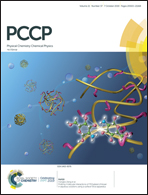Defects in Li4Ti5O12 induced by carbon deposition: an analysis of unidentified bands in Raman spectra†
Abstract
Lithium titanate (Li4Ti5O12, LTO) has already occupied its niche as an anode material for high-power and long-lifespan lithium batteries, but some novel directions for basic and applied research are still open. One of the most promising approaches in improving its properties, e.g., electronic conductivity and rate capability, is based on controllable defect engineering. The “defects” may be intentionally introduced into LTO via doping, surface modifications, and the synergy between them. However, the defects, which have significant effects to the electrical and electrochemical properties, are usually extremely dilute. Reliable material characterizations are essential and challenging, but the instrumental tools for revealing dilute defects are still insufficient. Herein, detailed analyses on the surface or subsurface defects of carbon-coated LTO were performed using various material characterization methods. Raman spectroscopy has been identified as a unique tool for the probing of structural defects.



 Please wait while we load your content...
Please wait while we load your content...